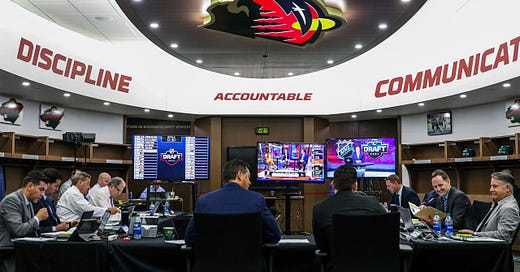Canadian University Hockey, USports has been a rapidly growing league when it comes to producing high-level talent. You have players like Artyom Duda at TMU, Connor Ungar at Brock, Luke Richardson of UNB, and plenty more who reach the ECHL. The recruiting aspect of the league is certainly unique. Obviously, you have your prospect targets but you never know which players from leagues like the QMJHL or OHL are aiming to make a transition. Focusing on prospects looking to make the leap from junior to university, I wanted to make a tool to project how forwards and defensemen from multiple leagues will translate to USports on a points basis.
Process
Luckily for my own sanity, I did not have to collect all of this data manually. I was able to utilize the Top Down Hockey scraper courtesy of Patrick Bacon. With this tool, I downloaded data starting from the 2020-2024 USports season as well as specific leagues. In the coming weeks I will be adding more leagues but to build a starting point I used the OHL, OJHL, GOJHL, BCHL, and MJHL. Once I had this data I identified the names that occurred in both one of these leagues and in USports. Once I had the targeted players I was able to put that into my code and identify the equivalencies for each league. Keep in mind that I did equivalencies separately for defensemen and forwards just to ensure accuracy.
Projected Points = PPG (Junior) × Equivalency × Games Played (USports)Results
So what leagues translated most to USports men’s hockey? It’s quite easy to guess that yes it is the OHL. There’s a reason it is the most NHL-drafted league. Coming in second is the BCHL following with the MJHL, OJHL, and GOJHL.
As with all research, this model has its limitations. For example, something I did in the past was conduct a correlation matrix to identify which statistics led to points in USports. I found that shots on goal, passes to the slot, scoring chances, and entries had a positive correlation with points, suggesting that a more advanced model incorporating these metrics could provide an even more accurate projection.
Conclusion
In a league where more often than not teams don’t have people working with data, the edge this work provides is significant. Beyond recruitment, this model has practical applications for coaching strategies, player development, and talent evaluation. For example, if we know that successful zone entries lead to a higher probability of points, we can tailor practices to improve this skill, giving players specific areas to work on that directly impact their performance. By refining and expanding this research to include additional leagues and performance metrics, we can help teams make more informed decisions, while also helping players reach their full potential and providing them with the necessary tools to transition beyond USports.




